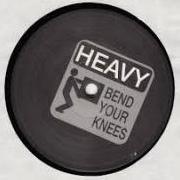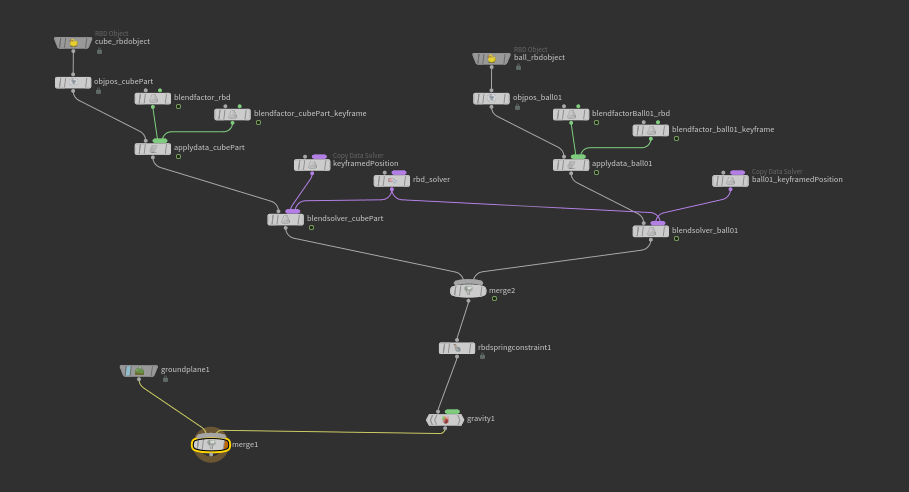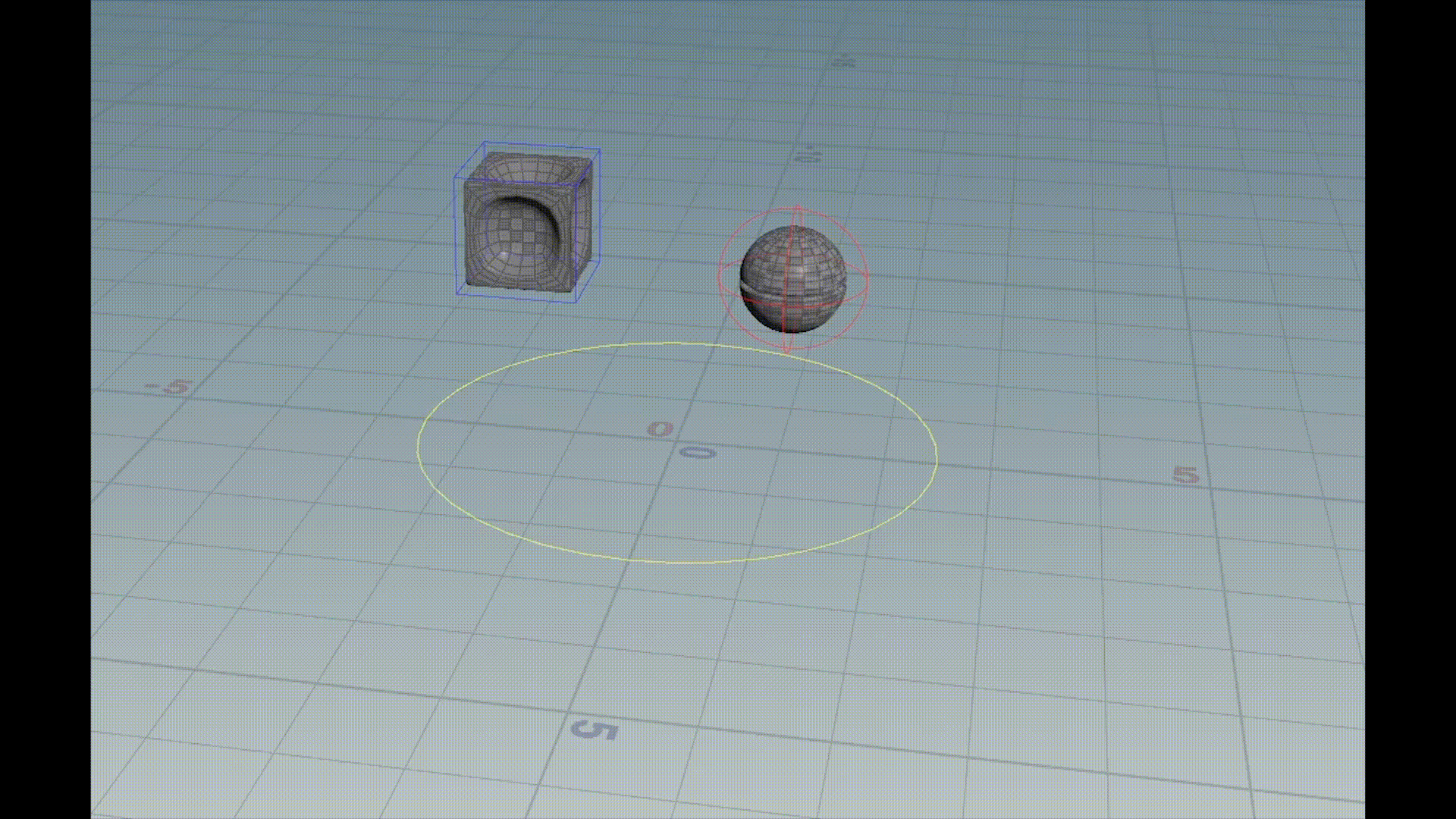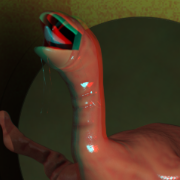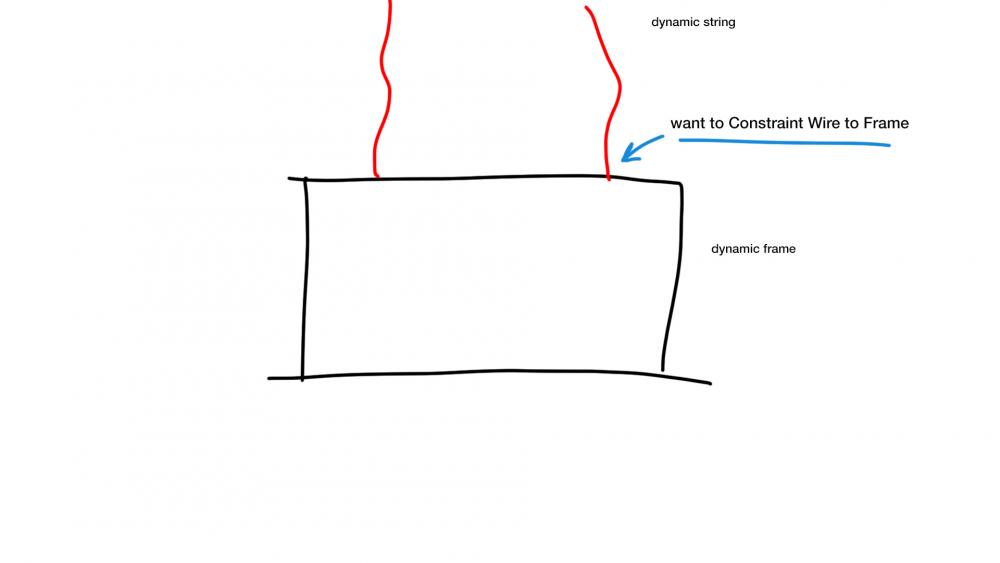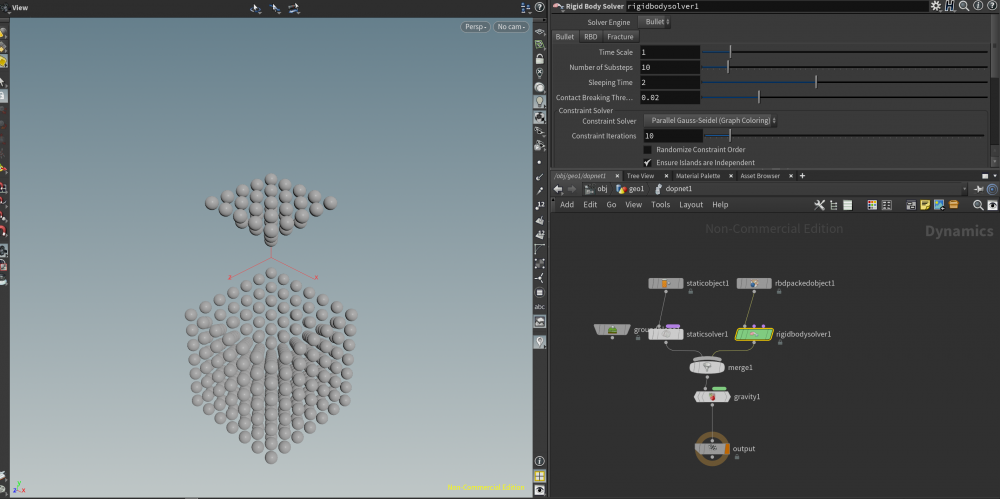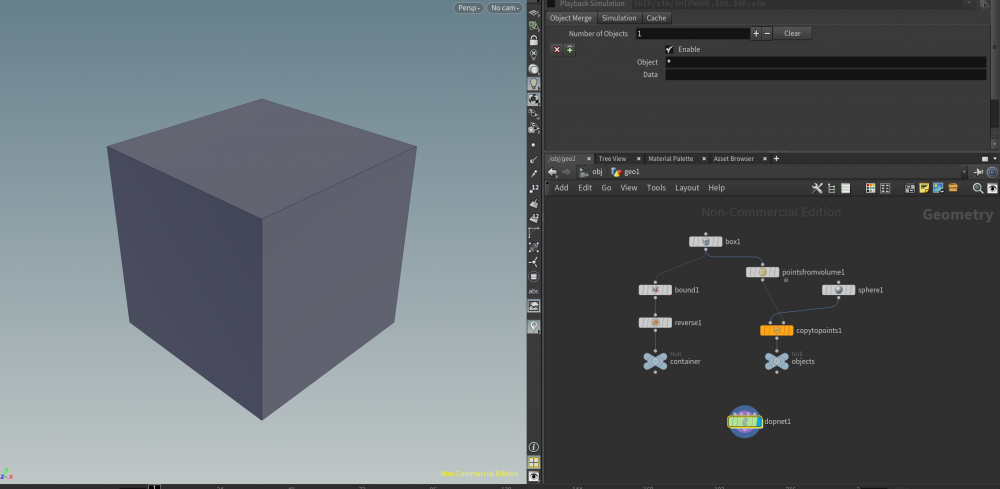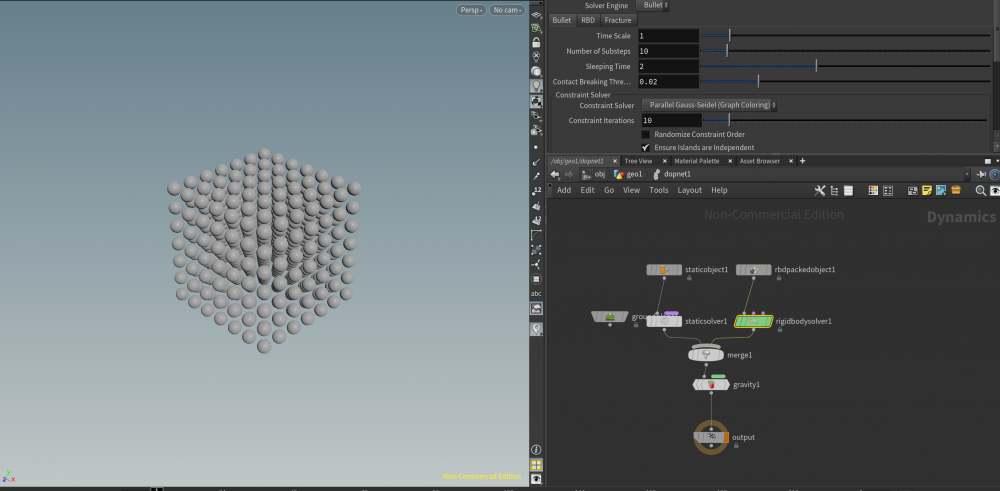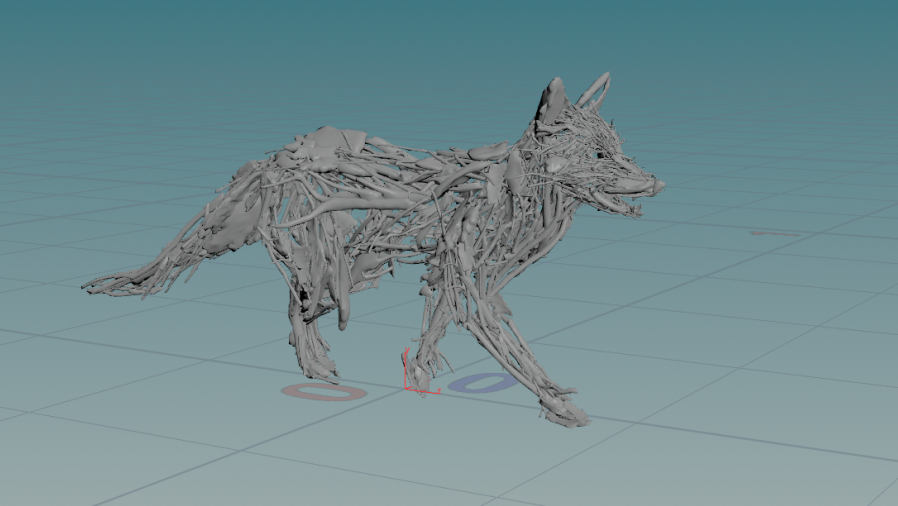Search the Community
Showing results for tags 'dynamics'.
-
Donuts & Cupcakes! What? This is the theme of my new 3D animation [V2] of dominoes falling down! The goal? Have fun and training my skills in 3D simulations under Houdini v18! Technical details : - Houdini 18 -> Modeling, textures of Cupcakes and Donuts, rigid body dynamics simulations, placement and cameras paths. - Blender 2.83.1 -> Textures, lights and rendering with Cycles, because Houdini's mantra is really too slow to calculate ... Now enjoy it and leave me likes and comments, it's always a pleasure !! Here : https://www.youtube.com/watch?v=0sFKkirxTbk
- 35 replies
-
- domino
- simulation
-
(and 2 more)
Tagged with:
-
Dear ODForcers, I have a question regarding increasing sub-steps to increase quality and accuracy of ANY dynamic sim [NB: this ALWAYS seems to be suggested by tutorials]. Obviously having less is helpful for iteration testing speed, however I find whenever I increase them I nearly always get dramatically different results, whether RBD, FLIP, PYRO, etc (or combos of these). Having had a bit of a think about this I was wondering what issues there are with cranking the sub-steps. I imagine 2 things may affect it: 1. Vector and Scalar quantities scaling differently (although maybe there's tricks in the solvers to get around this) (and surface stuff, 2D?) 2. [and I imagine this is the most important] Chaos Theory Anyway, trying to learn to be an FX TD from home and any advice and chat is MUCH appreciated. Thanks 5D
-
Hello, I'm just getting into vellum and the solver seems fast and cool but I'm trying a sim here where the geometry tries to attach to its collision geo, but that ends up being very jittery at the end with what seems to be no loss of energy. I've uploaded a scene file. I've tried to set @v to zero at the end and that still hasn't worked. What're the steps to making this solver behave? vellum_basics__jitter_02.hip
- 11 replies
-
- vellum
- simulation
-
(and 2 more)
Tagged with:
-
Hey, I was wondering how I can have the hero object inherit multiple incomming objects but treat them as seperate items. I can import one item, replicate it in dops and adjust each one with $OBJID but cannot import multiple layed out objects without having them act as one entity. hero.hiplc
- 3 replies
-
- hero object
- rbd
-
(and 1 more)
Tagged with:
-
I'm trying to get these two objects to move towards each other after they hit the ground. Blend solvers are being used to allow the objects to transition between their keyframed positions and dynamic states and I need to add an attractive force which is what the spring constraint is supposed to be for. If I plug it in and doing nothing to it outside of hooking up the constrained object and the goal object it works fine. However, I want to control the timing of it so it can work it into an animation. When I tried to keyframe the spring strength or activation parameters the constraint would stop working or not work properly. Result from keyframing the activation parameter. The objects do not pull towards each other, the constraint just keeps them in place. Node network Does anyone know why this is happening? Thanks in advance!
-
- dops
- rigid body
-
(and 7 more)
Tagged with:
-
Is there a way to dynamically add geometry to a vellum solver? I have a situation where I'm generating new patches of geometry every ten frames. The vellum solver is only solving for the first patch, but not picking up the rest. The newly created geo is showing up in the vellum configure node, but not the solver. Any ideas? Many thanks! -max
-
Is there a way to dynamically add geometry to a vellum solver? I have a situation where I'm generating new patches of geometry every ten frames. The vellum solver is only solving for the first patch, but not picking up the rest. The newly created geo is showing up in the vellum configure node, but not the solver. Any ideas? Many thanks! -max
-
Hey guys. On my "life goals" list there is this insane task of creating a dynamic car rig that is fully customizable for different shapes and sizes of cars (normal road cars, 4x4, race cars, etc) It should be something like the videos below. The reason behind this is I love cars (obviously) and I want to create a ton of car related stuff in houdini to learn dynamics, pyro, flip, grains but I don't want to spend too much time with setting up a vehicle and meticulously keyframe animate every aspect of it. The videos below look very realistic in terms of physics and they look like they're ready to be lit and rendered, and all these extra elements to be added. Needless to say that my intention is to share the setup if it ever gets this good. So what do you think would be the best way to approach this complex task? Is there already something out there that can be used for this? Ps: in the meantime I'm already downloading every hip and hda that is even remotely related to this topic
-
I have an alembic with a lovely bit of movement happening, lying down on a ground plane. I'd like to make parts of it floppy, which I can do with vellum and a pin to target with an attribute that scales the pin stiffness so it's lower on the floppier parts. No problem there. The part I'm not able to figure out is this: I actually want to hang this up by one of the floppy bits, but still be able to use the shivering/shuddering from the target animation. The target animation is apparently evaluated as absolute coordinates, rather than deltas of a rest mesh, so even with the floppy part being hung up, the pinned parts are still lying on the "ground"/seeking the actual point locations of the target. Is there a way where I can get it to evaluate the target so that even if some of the animated bits drift (and move some of the not-quite-100%-pinned areas) the vellum will incorporate the source object's animation, but at it's new simulated place? Thanks for any help!
-
Hi guys and girls, I have this condensation on bottle shot I'm working and would love to create a poisson disk distribution with a uniform sample of points based on the area of the triangles in the mesh. I've been looking at the papers written about this but its a liittle bit technical for me at this time. I'm hoping some could maybe look at my file and point me in the right direction to use vex to create this algorithm. Thanks much in advance. poisson_on_bottle_setup.hip
-
Hello! I've been using Houdini as a TD for about 2 years now and I just recently got my hands on a C4D and X-Particles license. Playing around with X-Particles it has become apparent that Houdini can make something fairly simple (like particle simulations with constraints) very difficult. For these past 2 years I've been trying to get, specifically, thick liquid like particle constraints (not just viscous but stringy) working in Houdini and I've never been able to get results I can be completely happy with. I've been able to achieve "sticky" effects using vellum grains and vdb meshing before as seen here, however, I was always after a different effect using a particle simulation that was NOT attached to a mesh but still behaved in a similar "sticky" fashion when coming in contact with colliders. After trying this over and over again in Houdini and having unsatisfactory results, I've now experimented with X-Particles and I was a slightly frustrated by all of the time I had spent in Houdini and how simple and quick it was to achieve exactly the effect I wanted in X-Particles. In the video below you can see what effect I was after in XP. I was curious if anyone at all has re-created this stringy liquid effect in Houdini with POPs? It seems clear to me that FLIP fluids are not really the answer for small scale simulations where you want a "stringy" surface tension look. I've gotten close with FLIP and vdb meshing in Houdini, but it never looks as natural and real as X-Particles. I've heard that maybe the POP Fluid node may be the answer (here), but I'm curious if anyone has attempted these stringy constraints in a Houdini project! Any Houdini workflow tips for such an effect would be appreciated because the cost of X-Particles and C4D is not something I plan on paying for the rest of my days!
- 2 replies
-
- xparticles
- gore
-
(and 11 more)
Tagged with:
-
Hi everyone, I have a plant (leaf and stem) merged as one piece of geo with some dynamic animation. I'd like to animate the leaf separately and still be able to keep the current animation. Is there anyway you guys can think of that I could do this in a procedural way? any suggestions would be much appreciated. Even if you have suggestion on how I could do it differently from scratch that would be appreciated too. See attached file. Thanks in advance. philodendron_model_03_for_forum.hip
- 3 replies
-
- procedural
- modeling
-
(and 3 more)
Tagged with:
-
I've been working on trying to solve a problem that probably has several ways to attack it... but I can't seem to figure this out. I'm trying to have an animated object that rocks back and forth, and inside of that object is a hinge constraint that ideally would follow the object and let the gravity node do its thing. I the example file, Imagine a sailboat on the seas, rocking back and forth on the waves, and the boom rocks swings based on the boat's motion. I've attached a hip file to show my train of thought. Any help is appreciated. hinge_test.hiplc
-
Hi guys, Happy to share this with you! Let me know what you think! Cheers, Manu
-
Hey all, I need help with something I think should be relatively easy but cannot figure it out. I want to drop a picture frame in with strings attached using vellum. I have set up the wires but cannot figure out the correct approach to attach to the frame. I have a attached the beginning of my set up maybe someone can help me out or give me some advice! Thanks! vellum_frame_jl_01.hiplc
-
Hi. I was digging in SideFX DOPs documentation and noticed such nodes as Cloth Mass Properties, Cloth Material, Cloth Material Behavior, Cloth Plasticity Properties and other cloth related nodes that seem to be missing in Houdini 18. Are they legacy nodes I don't have to care about or have I misunderstood something?
-
Hi I'm new to Houdini and recently I've been getting into DOPs. I have a question I've been trying different things out in dops to see how they work, been playing around with the "Gas Match Field" node and found that it works quite nicely when both fields you are supplying the node with are from the same object Like on picture 1, both the "myField" field and the "heat" field are part of the same object and the node works just fine But what I can't figure out is how to make the node work when I'm supplying it with fields from different objects. On picture 2 "myField" is part of an empty object and the "heat" field is part of the smoke object, I tried to reference them via their paths like on the picture 2 but unfortunately it doesn't seem to work. Does anyone have any insight into why this may be, I can see how referencing field from different objects can come in handy not just for this scenario.
-
This is a bit fx, a bit modeling, a bit rendering, so I'm throwing it here-- I am running sims on a tree model. The original tree was too hi-res to simulate, so I had to run Clean and Remesh to reduce its poly count a little bit. It still proved too oddly-modeled to run a point deform on the original based on the sim, but the sim'd model is still high-poly enough so we're going to use it as the final. What I need to do is transfer the UVs, in world space, from the original model to the down-res'd sim'd model. I tried using Maya's Transfer Attributes, which does exactly what I need, but choked on the source model's size. How can I do this in Houdini? (I know there will be some changes, but those should be mostly in the little tiny branches that are okay to lose, and this is not a hero tree.) I assume it will be something like storing the original models' point positions and then somehow applying those points to the end result of the sim'd/cached model, at which point I could do a straight attribute transfer (and although I get this theory I don't know the steps required), or is there a better way (and if not, how would I do my suggested way)? Thanks so much!
-
Hey people of the internet, I feel like I'm being really dumb and I cant work this out. I haven't had much experience with RBD solvers because I usually use C4D for these sort of simple setups. Basically I have a load of spheres inside a box and I want the box to contain them. Unfortunately, the spheres just pass through. I have fiddled with it and can get it to work. If it's set to bullet it sticks some of the spheres and the rest pass through. I have attached a screenshot of my set up.
-
Hey guys! I'm struggling a bit with a setup that's probably quite simple but I couldn't get behind it for a couple of days now. My shot requires me to have pieces which a character consists of (Megascan-assets scattered on a character) follow the character's animation. This looks something like this: walkcycle_fox.mp4 Now what I've tried to far was to go about the following with some fancy orientation math in a SOP-Solver in the dopnet to get the euler-W-acceleration to target the goal-orientation, but somehow the pivot offsets made this way harder than expected. My next approach (which I should have rolled with from the beginning) are constraints. So I'll try to have a soft constraint for each piece to a world anchor and target the rotation. But just how exactly does rotation-constraining work with the RBD-tools? I've found very little information on this topic - only for things that are individual objects, but not 800 pieces... I'm happy for any hint towrads a solution. Cheers, Martin
-
Hello everyone, I've stumbled upon a problem. What I need to do is simulate thousends (15-30k) individual rice corns. To make it harder, everything should be about real life scale. I've got a setup that emits packed rbd objects, but it gets slow very quickly. What I would like to do is, to set the bullet objects to sleep after they lived for a few frames. The settings for automatic sleeping won't give me the desired result. Adding a Attribute wrangle into the SOP Solver (as I've seen in other setups) disables all rbd objects instead of those that lived more than 5 frames. Any help would be appreciated. I've attached the file where I'm testing this in a crude way. Thank you all! Rice.hiplc
-
Hi Does anyone know good tutorials for learning Explosions? Thx in Regards Balaji J
-
Hi Guys. This my first post!!! I have been working on a scene where some particles emitted from a POPsop, scaling inside a DOPsop, colliding with each other and fill a container. I have seen this dynamic in a lot of videos, but I never be able to do that (below an example) I think I'm very close to do that, but I don't know is the right way. I did it with the multisolver in the dop network. I attach my project in the post. I did'nt find any tutorial or forum that explain that. Someone can help me please? There is also a trick to stop emission when the volume is almost fill? Thank you. Luther Fill_Object_With_PP_002.hiplc
-
I'm looking to find a way to make a FLIP fluid sim move particles, which would themselves be used to instance underwater particulate matter or bubbles. All of my Googling turns up ways to make POPs influence FLIPs, but I'm unable to find this, and I'm sure it's depressingly easy. The scene is a pre-animated character diving into water. To get the bubbles as he dives it looks like the best bet will be to emit particles with instanced geo bubbles (correct? No matter how splashy I make the sim, I'm not getting any bubbles happening from the dive itself). Thanks for any help!
-
Hi peeps, I'm using the SOP solver DOP to change my geometry overtime from one sphere to multiple spheres, however, when the geometry changes to multiple spheres it's still behaving like just one object instead of individual spheres and I can't figure out why! Any help would be much appreciated and I've attached the troublesome scene file. Also, I used the RBD Fracture object for this instead of the RBD packed, because I couldn't get the results out of the SOP solver to work with RBD packed object. I unpacked the geo in the SOP solver and repacked the output with the name attribute and it wouldn't work, so also, if anyone could shed some light on that as well it would be much appreciated. Thanks. RBDs_SOP_solver_testing_01.hip

